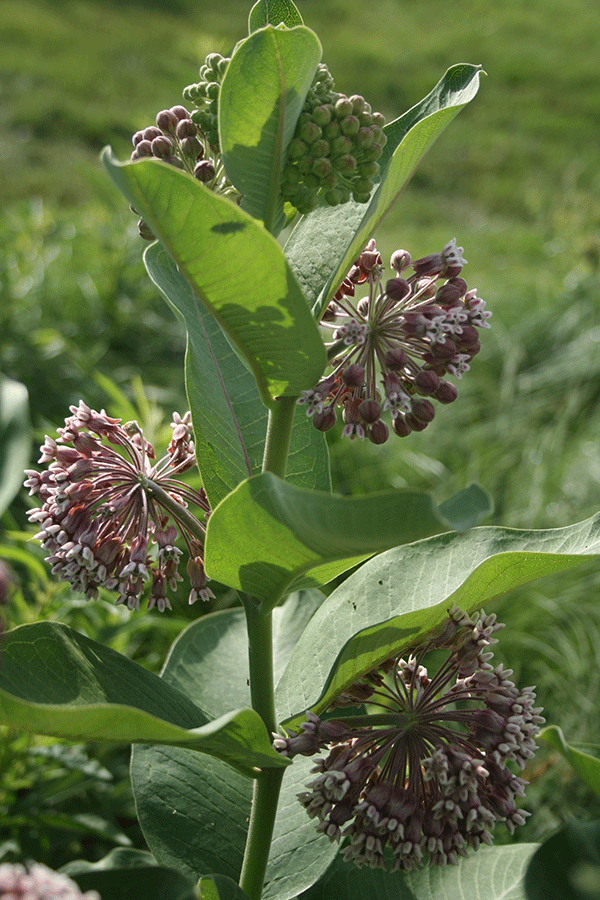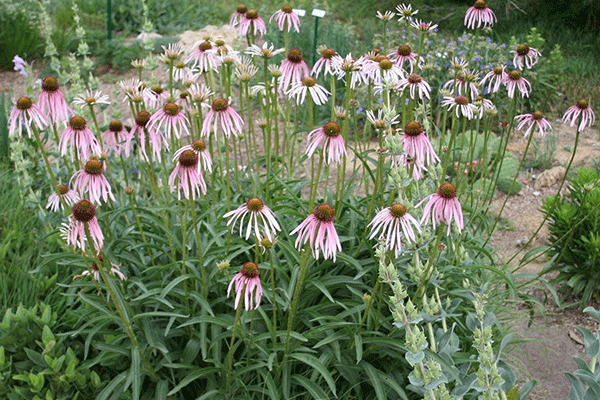Native wildflowers and grasses have a rich history here on the Great Plains. They not only provided shelter, structure and beauty but were also used by Native Americans and prairie pioneers for food, ceremonies and play. Below is a brief list of some of the most commonly used plants.
Butterfly milkweed, Asclepias tuberosa, was called raw medicine because the root was used without boiling for bronchial and pulmonary trouble. It was also chewed and put into wounds, or dried and pulverized to place on cuts and stubborn sores.
 Common milkweed, Asclepias syriaca.
Common milkweed, Asclepias syriaca.Common milkweed, Asclepias syriaca, was used for food at three stages of its growth—the young sprouts in early spring were used like asparagus; the clusters of floral buds were used fresh or cooked; and the firm, green young fruits were boiled. Young boys chewed the fiber of the mature stalks to turn it into popgun wads.
Narrowleaf coneflower, Echinacea angustifolia, was used as a remedy for more ailments than any other plant. It was an antidote for snake and other venomous bites and stings, burned as a smoke treatment for headaches or, for horses, for distemper. It was placed on burns, on aching teeth or on enlarged glands (e.g. mumps).
Purple poppy mallow, Callirhoe involucrata. The leaves were cooked to thicken stews. The starchy tubers taste somewhat like sweet potatoes and were eaten raw, roasted or boiled. And although they lack flavor, the wine-colored flowers are a beautiful addition to salads.
Purple prairie clover, Dalea purpurea. The Pawnee name “broom weed” referred to the use of the tough, elastic stems to make brooms. Oglala dried the fragrant leaves to make a tea and the Ponca chewed its roots for their pleasant taste.
Soapweed, Yucca glauca, roots were soaked in water to make a sudsy soap for washing hair. It was also used to make fires on the treeless prairie—the hard, sharp-pointed blades were bound together with sinew to make a fire drill and the stems, peeled and dried, were used to start fires. Leaves were pounded to reveal fibers that were used as thread and the tips were used as needles. Immature flower spikes were boiled and eaten like asparagus and the mature flower petals were eaten raw.
Spiderwort, Tradescantia ohioensis, also called snotweed and cow-slobbers, was named for the mucilaginous juice drawn out like a spider’s thread when a leaf or stem is broken. The Lakota made a blue paint from the flowers. Cherokee made a tea for the treatment of "female" problems and a laxative for stomach and kidney problems. The sap was used for skin conditions. Perhaps most importantly, a poultice of crushed leaves plants helped treat insect bites and stings. Leaves were eaten raw or cooked in soups or stews, while the stalks were cooked like asparagus. The leaves and roots are still used as alternative medicines by medical herbalists.
Leadplant, Amorpha canescens, was called “buffalo bellow plant” because it was the dominant prairie flower during rutting season. The Lakotas dried the leaves for tea or mixed them with buffalo fat for pipe tobacco; and the stems were used by the Omaha to treat neuralgia and rheumatism.
Sources: Uses of Plants by the Indians of the Missouri River Region by Melvin Gilmore and Medicinal Plants of the Prairie: An Ethnobotanical Guide by Kelly Kindscher
Nebraska Statewide Arboretum is a nonprofit that works toward sustainable home and community landscapes through initiatives in education, public gardens and the environment. Plant and landscape resources at http://arboretum.unl.edu.

